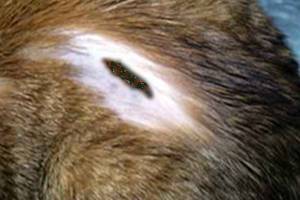7 Ways To Treat A Bleeding Wound On A Cat
Cats are animals that love to roam outdoors. That's why it's not uncommon for us to find cats injured and bleeding. Bleeding wounds in cats are often caused by glass, gravel, cat fighting, throwing people, cat accidents and so on.
When a cat is injured, the first thing we as owners think of is how to treat this bleeding cat wound so that the cat will not feel sick and uncomfortable with his current body condition.
Then how to treat a cat's leg that is injured and bleeding ? For those of you who want to know the answer, please read Angora's article below. Read slowly and until the end, Good Readers, so you don't make a mistake in applying it.
7 Ways To Treat Bleeding Cat Wounds
An injured cat must be treated immediately so that the wound does not get worse. In caring for a cat with a bleeding wound, there are many things that we need to pay attention to and we cannot take care of it carelessly. So that you are not wrong then you can follow the method below :
1. Look For Foreign Objects That Make Wounds On The Cat's Body
The first thing we have to do is find out if there is a foreign object that has injured the cat's body that is still attached to his body. These foreign objects can be nails, glass, thorns, bones, sharp wood chips and other sharp objects.
If there are foreign objects that are harmful to the cat's body then you should first remove these objects from the cat's body. Gently pull from the cat's wound so that the cat's wound does not widen. After successfully removed, the next step is to clean the cat's wound.
2. Clean Cat Wounds
After you check the cat's wound, the next step is to clean the bleeding wound. Clean the wound from blood or dirt that is still attached. Clean the wound until the wound feels completely clean. To clean the wound, use a water mix salt.
You can make a water mix salt by mixing one liter of water with 1 teaspoon of salt. Then stir until the water and salt are slightly combined, stirring for about 10 minutes. Do not occasionally use alcohol or hydrogen peroxide to clean a cat's wound.
Because this compound is considered dangerous because it can damage cat skin cells. We recommend using clean water or a water mix salt to clean the cat's wound. Oh yes, when cleaning cat wounds, it is recommended to use a clean cloth instead of using cotton.
This is done to avoid infection wounds and make it easier to clean the cat's wounds.
3. Stop The Blood Flowing
Stopping the blood flowing is mandatory after the wound is clean of foreign objects, blood or dirt. Stopping the blood can be done by pressing the wound and then covering it with gauze. You can also lift the injured body part at an altitude higher than your heart.
This method is one way that is quite effective in preventing blood from flowing to the injured body part so that the bleeding can be temporarily stopped before the wound is covered with gauze.
4. Use E Collar
The next way is to use the E Collar. After the bleeding has stopped and the wound has been covered with gauze, the next step is to apply an E Collar to the cat. This E Collar is a special medical tools for animals such as dogs and cats.
Its function is to prevent the cat from licking or biting the wound which has been closed. If you don't use this tool, the cat will often damage the wound cover and bite and lick the cat's wound. This can slow down the wound healing process and can cause the wound to widen or get worse.
For those of you who are confused about where to buy this tool, you can easily buy this tool at a pet shop or online store. For the price itself is quite cheap, which is only around 4 dollars and above. Now for the installation of this tool to the cat is quite easy to do, you can even do it yourself without the help of others.
5. Cage Cats
Sometimes even though some cats have been given an E Collar, they still don't want to stay still and move here and there. If your cat is very active and you are worried that the wound will be difficult to heal, you can cage the cat to limit its movement.
Generally this is done in cases of rather severe injuries. For minor injuries, putting a cat in a cage is not mandatory.
6. Pay Attention To The Condition Of The Cat
The sixth step that we can do after applying the 5 steps above is to pay attention to the condition of the cat. Pay attention to whether the cat's wound is getting better day by day. Healing can be known by looking at whether the wound is closing, drying and blackening.
If the wound is getting better then you can breathe easy but if the wound is getting worse, such as rotting, festering and the like, it is recommended to take the cat to the vet as soon as possible.
7. Take The Cat to the Vet
Using the method above, most cats with minor bleeding wounds will heal within a few days or weeks. However, if the cat's wound does not heal or even gets worse, the cat should be taken to the vet for treatment.
The vet will treat the wound, stitch the wound, give medicine and vitamins to help the wound heal. Sometimes doctors will also suggest medical actions such as surgery for wounds that they consider severe.
Is It Possible To Recover From The Wound Above The Cat ?
Of course its can, as long as the cat's wound that bleeds is not a deep wound or a serious wound. By using the above method in a few days the cat's wound will dry up then will heal completely after more than a week.
For severe injuries, the above method cannot heal the cat. In need of medical action such as surgery or skin suturing. But even so, you can use the above method as a first aid measure before taking your cat to the vet.
Is There A Way To Speed Up The Cat's Healing Process ?
Speeding up the cat's healing process can be done by using an E Collar and limiting the cat's movement by putting it in a cage. In addition, you can also give the cat nutritious food that is specifically intended for healing sick cats.
This type of food is widely sold in pet shops or online stores. One example of a special food to help heal a sick cat is Royal Canin Recovery. Include also the provision of vitamins along with the provision of nutritious food.
Maybe that's all the discussion about how to treat a cat that is injured and bleeding. With this article, we hope that you will be able to treat your cat independently at home.








